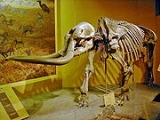
Stegomastodon
Encyclopedia
Stegomastodon is an extinct genus of gomphothere
, a family of proboscidea
ns. It is not to be confused with the genus Mammut
from a different proboscidean family
, whose members are commonly called "mastodons", nor with the genus Stegodon
, from yet another proboscidean sub-family
, whose members are commonly called "stegodonts".
It stood 2.8 metres (9.2 ft) tall and looked like a robust version of the modern elephant
. It weighed about 6000 kilograms (13,227.7 lb). Like modern elephants, but unlike most of its closer relatives, it had just two tusks. These tusks curved upwards and were about 3.5 metres (11.5 ft) long. Stegomastodons molars
were covered in enamel
and had a complex pattern of ridges and knobbly protrusions on them, giving the creature a large chewing surface that enabled it to eat grass
. It lived in North and South America, and its brain weighed about 11 pounds (5 kg).
The two South American species arrived following the Great American Interchange
. They were initially mixed feeders; S. waringi evolved towards grazing
, while S. platensis evolved towards browsing
. The Stegomastodon species occupied warmer, lower-altitude habitats east of the Andes
, while the related gomphothere Cuvieronius hyodon
occupied cooler, higher-altitude habitats.
Gomphothere
Gomphotheriidae is a diverse taxonomic family of extinct elephant-like animals , called gomphotheres. They were widespread in North America during the Miocene and Pliocene epochs, 12-1.6 million years ago. Some lived in parts of Eurasia, Beringia and, following the Great American Interchange,...
, a family of proboscidea
Proboscidea
Proboscidea is a taxonomic order containing one living family, Elephantidae, and several extinct families. This order was first described by J. Illiger in 1881 and encompasses the trunked mammals...
ns. It is not to be confused with the genus Mammut
Mastodon
Mastodons were large tusked mammal species of the extinct genus Mammut which inhabited Asia, Africa, Europe, North America and Central America from the Oligocene through Pleistocene, 33.9 mya to 11,000 years ago. The American mastodon is the most recent and best known species of the group...
from a different proboscidean family
Mammutidae
Mammutidae is a family of extinct proboscideans that lived between the Miocene to the Pleistocene or Holocene. The family was first described in 1922, classifying fossil specimens of the type genus Mammut , and has since been placed in various arrangements of the order...
, whose members are commonly called "mastodons", nor with the genus Stegodon
Stegodon
Stegodon , is a genus of the extinct subfamily Stegodontinae of the order Proboscidea. It was assigned to the family Elephantidae , but has also been placed in Stegodontidae . Stegodonts were present from 11.6 mya to 4,100 years ago...
, from yet another proboscidean sub-family
Elephantidae
Elephantidae is a taxonomic family, collectively elephants and mammoths. These are terrestrial large mammals with a trunk and tusks. Most genera and species in the family are extinct...
, whose members are commonly called "stegodonts".
It stood 2.8 metres (9.2 ft) tall and looked like a robust version of the modern elephant
Elephant
Elephants are large land mammals in two extant genera of the family Elephantidae: Elephas and Loxodonta, with the third genus Mammuthus extinct...
. It weighed about 6000 kilograms (13,227.7 lb). Like modern elephants, but unlike most of its closer relatives, it had just two tusks. These tusks curved upwards and were about 3.5 metres (11.5 ft) long. Stegomastodons molars
Molar (tooth)
Molars are the rearmost and most complicated kind of tooth in most mammals. In many mammals they grind food; hence the Latin name mola, "millstone"....
were covered in enamel
Tooth enamel
Tooth enamel, along with dentin, cementum, and dental pulp is one of the four major tissues that make up the tooth in vertebrates. It is the hardest and most highly mineralized substance in the human body. Tooth enamel is also found in the dermal denticles of sharks...
and had a complex pattern of ridges and knobbly protrusions on them, giving the creature a large chewing surface that enabled it to eat grass
Grass
Grasses, or more technically graminoids, are monocotyledonous, usually herbaceous plants with narrow leaves growing from the base. They include the "true grasses", of the Poaceae family, as well as the sedges and the rushes . The true grasses include cereals, bamboo and the grasses of lawns ...
. It lived in North and South America, and its brain weighed about 11 pounds (5 kg).
The two South American species arrived following the Great American Interchange
Great American Interchange
The Great American Interchange was an important paleozoogeographic event in which land and freshwater fauna migrated from North America via Central America to South America and vice versa, as the volcanic Isthmus of Panama rose up from the sea floor and bridged the formerly separated continents...
. They were initially mixed feeders; S. waringi evolved towards grazing
Grazing
Grazing generally describes a type of feeding, in which a herbivore feeds on plants , and also on other multicellular autotrophs...
, while S. platensis evolved towards browsing
Browsing (predation)
Browsing is a type of herbivory in which an herbivore feeds on leaves, soft shoots, or fruits of high growing, generally woody, plants such as shrubs. This is contrasted with grazing, usually associated with animals feeding on grass or other low vegetation...
. The Stegomastodon species occupied warmer, lower-altitude habitats east of the Andes
Andes
The Andes is the world's longest continental mountain range. It is a continual range of highlands along the western coast of South America. This range is about long, about to wide , and of an average height of about .Along its length, the Andes is split into several ranges, which are separated...
, while the related gomphothere Cuvieronius hyodon
Cuvieronius
Cuvieronius is an extinct New World genus of gomphothere. It is named after the French naturalist Georges Cuvier, stood 2.7 m tall and looked like a modern elephant except for its spiral-shaped tusks.-Origin:...
occupied cooler, higher-altitude habitats.

